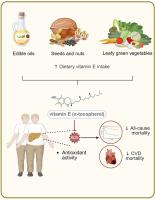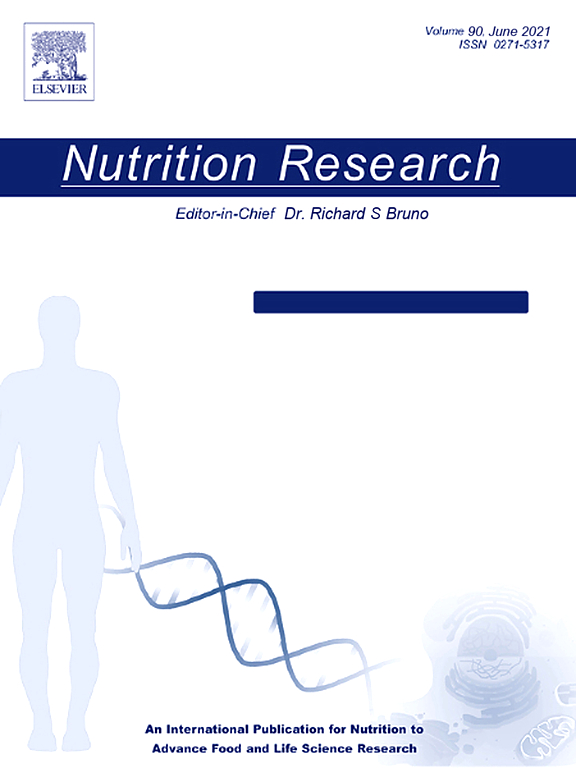Dietary vitamin E intake is associated with lower mortality among individuals with metabolic dysfunction-associated steatotic liver disease
IF 3.1
3区 医学
Q2 NUTRITION & DIETETICS
引用次数: 0
Abstract
Metabolic dysfunction-associated steatotic liver disease (MASLD) has become a prominent global health issue within the realm of chronic liver diseases. Dietary interventions are of utmost importance in its management. This research, grounded in data from the National Health and Nutrition Examination Survey (NHANES) spanning 1999-2018 and the National Death Index (NDI), was designed to clarify the association between dietary vitamin E intake and mortality among MASLD patients. Our hypothesis proposed that higher dietary vitamin E intake might be inversely associated with a lower risk of mortality in this population. A total of 7883 MASLD patients were enrolled. Their dietary vitamin E intake was accurately measured via the USDA's standardized method, and numerous confounding factors were comprehensively taken into account. The findings indicated that a higher dietary vitamin E intake was significantly linked to a decreased risk of both all-cause and cardiovascular disease (CVD) mortality in MASLD patients. Kaplan-Meier curves and Cox regression models vividly depicted this inverse correlation. Subgroup and sensitivity analyses further verified the reliability of the results, showing that nonsedentary patients were more sensitive to the protective effects of vitamin E. Notably, the improvement of mortality was particularly significant in patients with increased total bilirubin and fibrotic liver. This study offers valuable perspectives on the potential role of dietary vitamin E in MASLD management. It suggests that increasing dietary vitamin E intake could be a promising preventive approach.

在代谢功能障碍相关的脂肪变性肝病患者中,膳食维生素E摄入量与较低的死亡率相关
代谢功能障碍相关脂肪变性肝病(MASLD)已成为慢性肝病领域中一个突出的全球健康问题。饮食干预对其管理至关重要。这项研究基于1999年至2018年国家健康与营养调查(NHANES)和国家死亡指数(NDI)的数据,旨在阐明MASLD患者膳食维生素E摄入量与死亡率之间的关系。我们的假设提出,在这一人群中,较高的膳食维生素E摄入量可能与较低的死亡率风险呈负相关。共有7883名MASLD患者入组。他们的膳食维生素E摄入量是通过美国农业部的标准化方法精确测量的,并综合考虑了许多混杂因素。研究结果表明,较高的膳食维生素E摄入量与MASLD患者全因和心血管疾病(CVD)死亡率的降低显著相关。Kaplan-Meier曲线和Cox回归模型生动地描述了这种负相关关系。亚组分析和敏感性分析进一步验证了结果的可靠性,表明不久坐的患者对维生素e的保护作用更敏感。值得注意的是,总胆红素升高和肝纤维化的患者死亡率的改善尤为显著。本研究为膳食维生素E在MASLD管理中的潜在作用提供了有价值的观点。这表明增加饮食中维生素E的摄入量可能是一种很有希望的预防方法。
本文章由计算机程序翻译,如有差异,请以英文原文为准。
求助全文
约1分钟内获得全文
求助全文
来源期刊

Nutrition Research
医学-营养学
CiteScore
7.60
自引率
2.20%
发文量
107
审稿时长
58 days
期刊介绍:
Nutrition Research publishes original research articles, communications, and reviews on basic and applied nutrition. The mission of Nutrition Research is to serve as the journal for global communication of nutrition and life sciences research on diet and health. The field of nutrition sciences includes, but is not limited to, the study of nutrients during growth, reproduction, aging, health, and disease.
Articles covering basic and applied research on all aspects of nutrition sciences are encouraged, including: nutritional biochemistry and metabolism; metabolomics, nutrient gene interactions; nutrient requirements for health; nutrition and disease; digestion and absorption; nutritional anthropology; epidemiology; the influence of socioeconomic and cultural factors on nutrition of the individual and the community; the impact of nutrient intake on disease response and behavior; the consequences of nutritional deficiency on growth and development, endocrine and nervous systems, and immunity; nutrition and gut microbiota; food intolerance and allergy; nutrient drug interactions; nutrition and aging; nutrition and cancer; obesity; diabetes; and intervention programs.
 求助内容:
求助内容: 应助结果提醒方式:
应助结果提醒方式:


